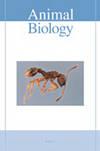Roost selection and ecology of Hipposideros pomona in China
IF 0.9
4区 生物学
Q2 ZOOLOGY
引用次数: 2
Abstract
Hipposideros pomona is a typical cave-dwelling bat (IUCN endangered), and its roost selection mechanism has not been studied. From January 2018 to December 2020, 135 potential roosts were investigated in mainland China. To understand the impact of cave microclimate, structure, surrounding and human disturbance on roost selection of H. pomona, 16 variables related to microclimate and roost characteristics were measured. The differences in environmental conditions in the roost of this species in different seasons were studied. The roost preferences of H. pomona were evaluated using independent-samples t-tests and chi-squared tests. The major environmental factors affecting the selection of roosts were determined by principal components analysis (PCA). The results were as follows: (1) H. pomona preferred free-hanging with a cluster spatial arrangement in small rooms deep in the caves. (2) H. pomona and other species of bats all tended to live in natural caves. However, compared to other bats, H. pomona preferred to roost in caves with relatively lower cave ceilings, more entrances, and farther from residential areas. Roosts of H. pomona were warmer and wetter with significantly lower levels of disturbance than those without H. pomona. (3) H. pomona preferred to hibernate in natural caves with little human disturbance and higher temperature and relative humidity. (4) Compared with nonbreeding roosts, breeding roosts of H. pomona had more areas covered by water and had a higher temperature and relative humidity. (5) The PCA analysis showed that microclimate factors, structure factors, and geographical factors were significant environmental factors for H. pomona roost selection.中国pomona的栖息地选择与生态学
波莫纳海马是一种典型的洞穴蝙蝠(世界自然保护联盟濒危物种),其栖息地选择机制尚未得到研究。从2018年1月到2020年12月,中国大陆共调查了135个潜在栖息地。为了了解洞穴小气候、结构、周围环境和人为干扰对波莫纳栖息地选择的影响,测量了16个与小气候和栖息地特征相关的变量。研究了不同季节该物种栖息环境条件的差异。使用独立样本t检验和卡方检验来评估H.pomona的栖息偏好。采用主成分分析法确定了影响栖息地选择的主要环境因素。结果表明:(1)波莫纳喜欢在洞穴深处的小房间里自由悬挂,空间排列呈集群状。(2) H.pomona和其他种类的蝙蝠都倾向于生活在自然洞穴中。然而,与其他蝙蝠相比,H.pomona更喜欢栖息在洞穴天花板相对较低、入口较多、距离居民区较远的洞穴中。与没有H.pomona的雄鸡相比,H.pomonna的雄鸡更温暖、更潮湿,干扰程度明显更低。(3) H.pomona喜欢在人类干扰较少、温度和相对湿度较高的自然洞穴中冬眠。(4) 与非繁殖栖息地相比,波莫纳繁殖栖息地被水覆盖的面积更大,温度和相对湿度也更高。(5) 主成分分析表明,小气候因素、结构因素和地理因素是波莫纳选择栖息地的重要环境因素。
本文章由计算机程序翻译,如有差异,请以英文原文为准。
求助全文
约1分钟内获得全文
求助全文
来源期刊

Animal Biology
生物-动物学
CiteScore
2.10
自引率
0.00%
发文量
34
审稿时长
3 months
期刊介绍:
Animal Biology publishes high quality papers and focuses on integration of the various disciplines within the broad field of zoology. These disciplines include behaviour, developmental biology, ecology, endocrinology, evolutionary biology, genomics, morphology, neurobiology, physiology, systematics and theoretical biology. Purely descriptive papers will not be considered for publication.
Animal Biology is the official journal of the Royal Dutch Zoological Society since its foundation in 1872. The journal was initially called Archives Néerlandaises de Zoologie, which was changed in 1952 to Netherlands Journal of Zoology, the current name was established in 2003.
 求助内容:
求助内容: 应助结果提醒方式:
应助结果提醒方式:


